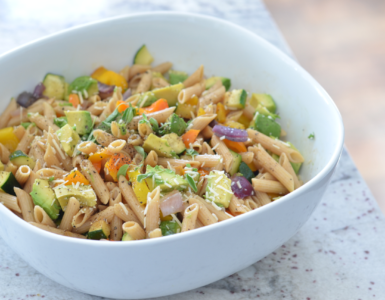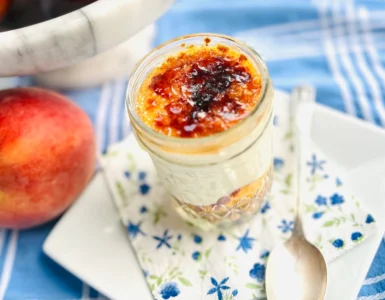6 ounces dry linguine
1/2 cup flour
1/2 teaspoon salt
1/4 teaspoon pepper
1/2 teaspoon onion powder
4 boneless skinless chicken breasts
4 tablespoons butter
1 cup reduced sodium chicken broth*
5-6 cups broccoli flowerets
1 can (10.75 oz.) cond. cream chicken soup
1 1/4 cups milk
1/2 cup lite mayonnaise*
1 teaspoon lemon juice
1/2 teaspoon curry
1 cup reduced fat shredded cheddar cheese*
Cook linguine according to package directions. Drain and keep warm while chicken is cooking.
Place flour, salt, pepper and onion powder in gallon plastic bag; shake to mix. Cut chicken into bite-size pieces; place in bag with flour mixture. Seal bag and shake to coat chicken with flour.
Over medium heat, melt butter in large skillet which has a lid (or use electric fry pan). Add chicken; brown, stirring as needed, until golden brown. Add 1/4 cup broth, reduce heat to simmer, cover and simmer 5-10 minutes (as needed, stir and add additional broth, 2-4 tablespoons at a time to keep chicken from burning). Arrange broccoli flowerets on chicken; add additional broth as needed (2-4 tablespoons at a time). Cover and simmer 10-15 minutes or until broccoli is desired tenderness. Remove chicken and broccoli to warm serving dishes, cover to keep warm.
Whisk together soup, milk, mayonnaise, lemon juice and curry powder; place in skillet used to cook chicken. Stirring constantly, heat thoroughly; add cheese and heat until melted. Thin to desired consistency with additional milk. To serve, place cooked linguine on plates; arrange with chicken and broccoli on top; spoon cheese sauce over top.
Notes:
* Regular broth, mayonnaise and cheese taste best in this recipe. Fat and sodium have been lowered in recipe by using reduced fat and low sodium products. Recipe serves 8
For nutrition analysis, go to www.dairy councilutnv.org.
QUICK TIP:
Label Ease – How to read labels to reduce fat, salt and sugar in cooking
Q – Seems obvious, but why do we need to worry about fat, sodium, and sugar?
A – Most Americans consume more calories than they need without meeting recommended nutrients
Q – Are there any benefits to fat, sugar, sodium – isn’t the lower the better?
A – Fat, sodium, sugar add desirable qualities to foods we eat
Fat digests slower – we’re not hunger as quick
Cooking Qualities
Texture, mouth feel
Taste – number 1 – if we do not like the taste, we will not continue to eat it
Q – So what is the key? How do we balance what we’re told we should do and what we like?
A – The key is balance – and we’ll do this by reading labels, and making informed choices
Example: Read labels and compare reduced products to regular – note, in processed foods – when one nutrient is lowered, another is increased
Mayonnaise
Condensed cream chicken soup
Cheese
Q – What’s the bottom line?
A – * Read labels and compare, product to product, size to size
* Balance the entire picture (recipe, meal, and diet), don’t focus on just one —-
* Moderation – manage serving size, strike a compromise – win the war, not the battle
Are the savings worth the switch? – Can I go part way?
Will it “cook” the way I want it to?
Is the taste and texture acceptable?















Add comment